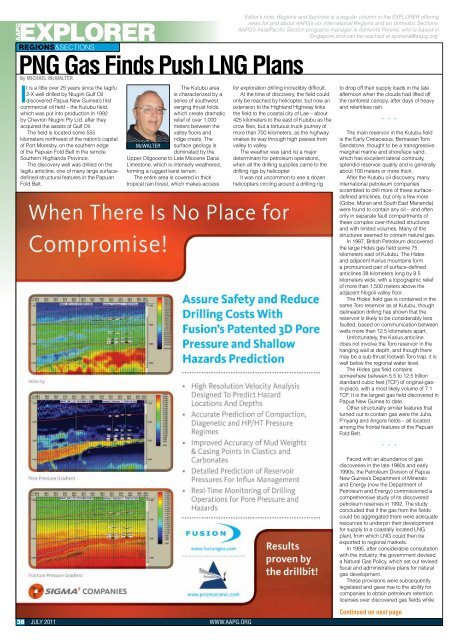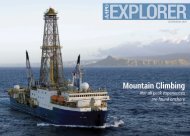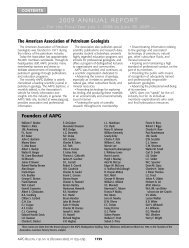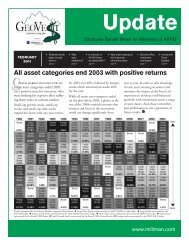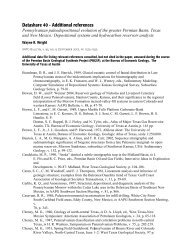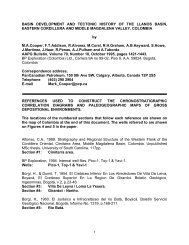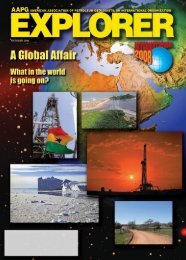AAPG Explorer - American Association of Petroleum Geologists
AAPG Explorer - American Association of Petroleum Geologists
AAPG Explorer - American Association of Petroleum Geologists
You also want an ePaper? Increase the reach of your titles
YUMPU automatically turns print PDFs into web optimized ePapers that Google loves.
<strong>AAPG</strong><br />
EXPLORER<br />
REGIONS&SECTIONS<br />
PNG Gas Finds Push LNG Plans<br />
By MICHAEL McWALTER<br />
It is a little over 25 years since the Iagifu<br />
2-X well drilled by Niugini Gulf Oil<br />
discovered Papua New Guinea’s first<br />
commercial oil field – the Kutubu field,<br />
which was put into production in 1992<br />
by Chevron Niugini Pty Ltd. after they<br />
acquired the assets <strong>of</strong> Gulf Oil.<br />
The field is located some 555<br />
kilometers northwest <strong>of</strong> the nation’s capital<br />
<strong>of</strong> Port Moresby, on the southern edge<br />
<strong>of</strong> the Papuan Fold Belt in the remote<br />
Southern Highlands Province.<br />
The discovery well was drilled on the<br />
Iagifu anticline, one <strong>of</strong> many large surfacedefined<br />
structural features in the Papuan<br />
Fold Belt.<br />
The Kutubu area<br />
is characterized by a<br />
series <strong>of</strong> southwest<br />
verging thrust folds,<br />
which create dramatic<br />
relief <strong>of</strong> over 1,000<br />
meters between the<br />
valley floors and<br />
ridge crests. The<br />
McWALTER surface geology is<br />
dominated by the<br />
Upper Oligocene to Late Miocene Darai<br />
Limestone, which is intensely weathered,<br />
forming a rugged karst terrain.<br />
The entire area is covered in thick<br />
tropical rain forest, which makes access<br />
38 JULY 2011 WWW.<strong>AAPG</strong>.ORG<br />
Editor’s note: Regions and Sections is a regular column in the EXPLORER <strong>of</strong>fering<br />
news for and about <strong>AAPG</strong>’s six international Regions and six domestic Sections.<br />
<strong>AAPG</strong>’s Asia/Pacific Section programs manager is Adrienne Pereira, who is based in<br />
Singapore and can be reached at apereira@aapg.org.<br />
for exploration drilling incredibly difficult.<br />
At the time <strong>of</strong> discovery, the field could<br />
only be reached by helicopter, but now an<br />
extension to the Highland Highway links<br />
the field to the coastal city <strong>of</strong> Lae – about<br />
425 kilometers to the east <strong>of</strong> Kutubu as the<br />
crow flies, but a tortuous truck journey <strong>of</strong><br />
more than 700 kilometers, as the highway<br />
snakes its way through high passes from<br />
valley to valley.<br />
The weather was (and is) a major<br />
determinant for petroleum operations,<br />
when all the drilling supplies came to the<br />
drilling rigs by helicopter.<br />
It was not uncommon to see a dozen<br />
helicopters circling around a drilling rig<br />
to drop <strong>of</strong>f their supply loads in the late<br />
afternoon when the clouds had lifted <strong>of</strong>f<br />
the rainforest canopy, after days <strong>of</strong> heavy<br />
and relentless rain.<br />
* * *<br />
The main reservoir in the Kutubu field<br />
is the Early Cretaceous, Berriasian Toro<br />
Sandstone, thought to be a transgressive<br />
marginal marine and shoreface sand,<br />
which has excellent lateral continuity,<br />
splendid reservoir quality and is generally<br />
about 100 meters or more thick.<br />
After the Kutubu oil discovery, many<br />
international petroleum companies<br />
scrambled to drill more <strong>of</strong> these surfacedefined<br />
anticlines, but only a few more<br />
(Gobe, Moran and South East Mananda)<br />
were found to contain any oil – and <strong>of</strong>ten<br />
only in separate fault compartments <strong>of</strong><br />
these complex over-thrusted structures<br />
and with limited volumes. Many <strong>of</strong> the<br />
structures seemed to contain natural gas.<br />
In 1987, British <strong>Petroleum</strong> discovered<br />
the large Hides gas field some 75<br />
kilometers east <strong>of</strong> Kutubu. The Hides<br />
and adjacent Karius mountains form<br />
a pronounced pair <strong>of</strong> surface-defined<br />
anticlines 38 kilometers long by 8.5<br />
kilometers wide, with a topographic relief<br />
<strong>of</strong> more than 1,500 meters above the<br />
adjacent Nogoli valley floor.<br />
The Hides’ field gas is contained in the<br />
same Toro reservoir as at Kutubu, though<br />
delineation drilling has shown that the<br />
reservoir is likely to be considerably less<br />
faulted, based on communication between<br />
wells more than 12.5 kilometers apart.<br />
Unfortunately, the Karius anticline<br />
does not involve the Toro reservoir in the<br />
hanging wall at depth, and though there<br />
may be a sub-thrust footwall Toro trap, it is<br />
well below the regional water level.<br />
The Hides gas field contains<br />
somewhere between 5.5 to 12.5 trillion<br />
standard cubic feet (TCF) <strong>of</strong> original-gasin-place,<br />
with a most likely volume <strong>of</strong> 7.1<br />
TCF. It is the largest gas field discovered in<br />
Papua New Guinea to date.<br />
Other structurally similar features that<br />
turned out to contain gas were the Juha,<br />
P’nyang and Angore fields – all located<br />
among the frontal features <strong>of</strong> the Papuan<br />
Fold Belt.<br />
* * *<br />
Faced with an abundance <strong>of</strong> gas<br />
discoveries in the late 1980s and early<br />
1990s, the <strong>Petroleum</strong> Division <strong>of</strong> Papua<br />
New Guinea’s Department <strong>of</strong> Minerals<br />
and Energy (now the Department <strong>of</strong><br />
<strong>Petroleum</strong> and Energy) commissioned a<br />
comprehensive study <strong>of</strong> its discovered<br />
petroleum reserves in 1992. The study<br />
concluded that if the gas from the fields<br />
could be aggregated there were adequate<br />
resources to underpin their development<br />
for supply to a coastally located LNG<br />
plant, from which LNG could then be<br />
exported to regional markets.<br />
In 1995, after considerable consultation<br />
with the industry, the government devised<br />
a Natural Gas Policy, which set out revised<br />
fiscal and administrative plans for natural<br />
gas development.<br />
These provisions were subsequently<br />
legislated and gave rise to the ability for<br />
companies to obtain petroleum retention<br />
licenses over discovered gas fields while<br />
Continued on next page


